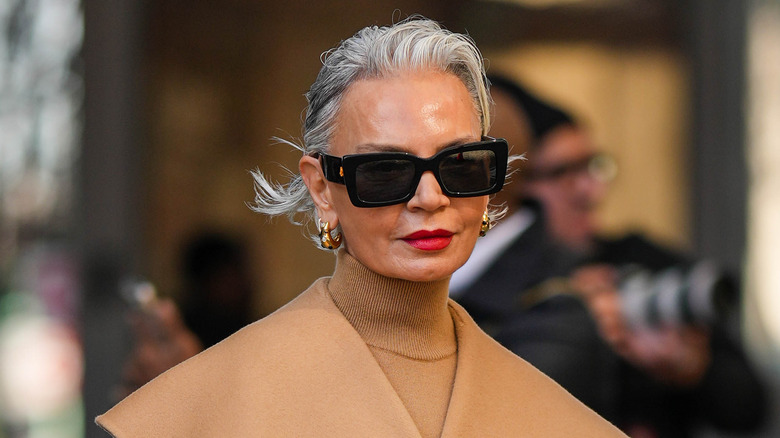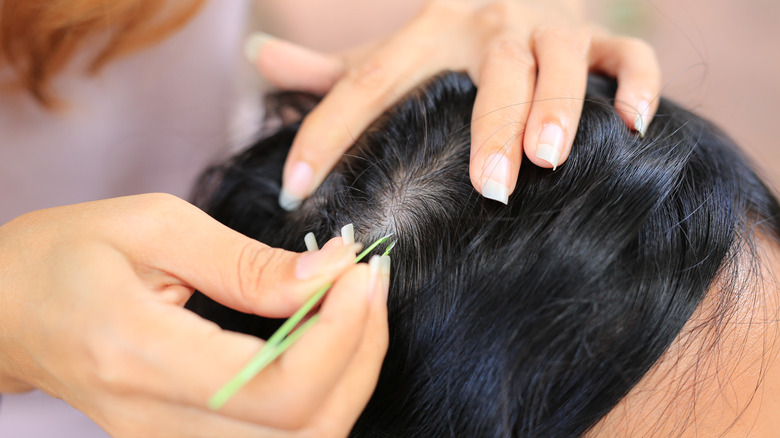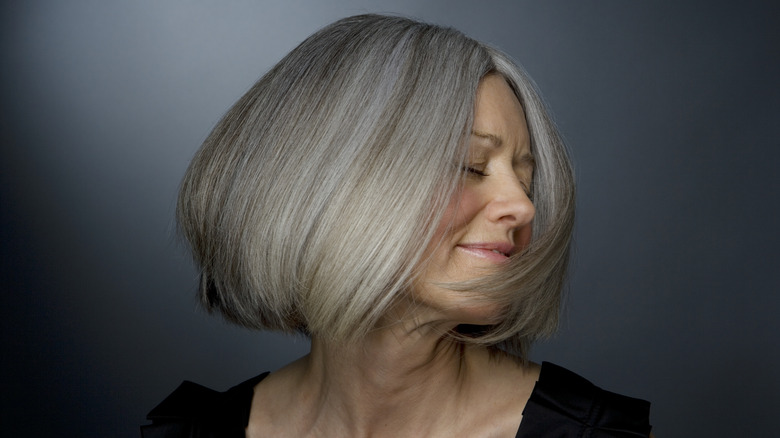Does Plucking A Gray Hair Really Cause More To Grow In Its Place?
For many of us, gray hair can be the bane of our existence. While the average individual starts going gray in their 30s, some can start in their 20s, depending on genetics. Going gray is a natural part of aging and will eventually happen to everyone, whether we like it or not. Hair can either become gray or white due to a lack of melanin, as, for reasons still not widely understood by experts, the number of stem cells that produce melanin declines as we age. That said, gray hair has been en vogue and trending since 2020.
Several celebrities, such as Andie MacDowell, Patrick Dempsey, and Jane Fonda have gone gray and chosen not to dye their hair. Nevertheless, it's easy to understand why the appearance of gray hair can cause an array of emotions. Psychologist Dr. Vivian Diller explained to Bustle, "While it's become more stylish and can even express beauty defiance, those first white hairs can trigger a deep fear of aging and, ultimately, our mortality." Instinctively, one might pluck the gray hair, bringing to mind the old saying, "every time you pull out a gray hair, more will grow in its place." But is this old wives tale true?
This is why you shouldn't pluck your gray hair
As it turns out, plucking one gray hair will not cause several other grays to sprout from your head. Dr. Shaskank Kraleti, M.D. from UAMS Health, explained, "Plucking a gray hair will only get you a new gray hair in its place because there is only one hair that is able to grow per follicle. Your surrounding hairs will not turn white until their own follicles' pigment cells die." The hair will likely start to grow back after three months. If you see more gray in your hair, it's not because you plucked a strand; it's because you're getting older.
However, if you continually pluck your gray hair, there can be unfortunate consequences. Hairstylist Trey Gillen told Real Simple, "Plucking can traumatize the hair follicle, and you can damage it to the point where it will no longer grow any hair." she added, "If you're a serial plucker, repeated 'plucking trauma' can even cause infection, scar formation, and bald patches."
Stylist Michael Van Clarke had a similar sentiment and said you should avoid plucking your gray hair because it does more harm than good. He said (via HuffPost), "more gray is coming anyway, as this is the trajectory of life. If you make plucking a habit when less than 1% of the head is gray, you'll have less hair to work with in a few years' time, when 10% of the hairs are gray."
Are there any solutions for gray hair?
Instead of plucking, Dr. Kraleti, told UAMS Health, "If there is a gray hair you must get rid of, very carefully cut it off." Although scientists are currently researching how to reverse gray hair (via eLife), there are other options. You can choose to go gray or dye your hair. Cassie Siskovic, an artistic director at haircare brand Alfaparf Milano Professional suggested to HuffPost to "Consult with your stylist on a hair placement and palette design that embraces your gray." She added, "It doesn't even mean you need to transition fully to gray, but it may make your maintenance way easier."
If you decide to embrace your gray hair, there are some things to keep in mind. Transitioning to gray hair from having natural or dyed hair can take time. You can either dye it gray at home or professionally. If you opt to go natural without professional help, Nemours KidsHealth states that it can take up to 10 years for all of your hair to gray.
Moreover, trichologist Glenn Lyons told Good Housekeeping that your hair texture could change, especially if you plucked your gray hair. He said, "Your hair may also 'feel' coarser if you pull out your first few grey hairs." Lyons explained, "This is because constant pulling-out of hair can distort your follicles, resulting in more crinkly hair."


